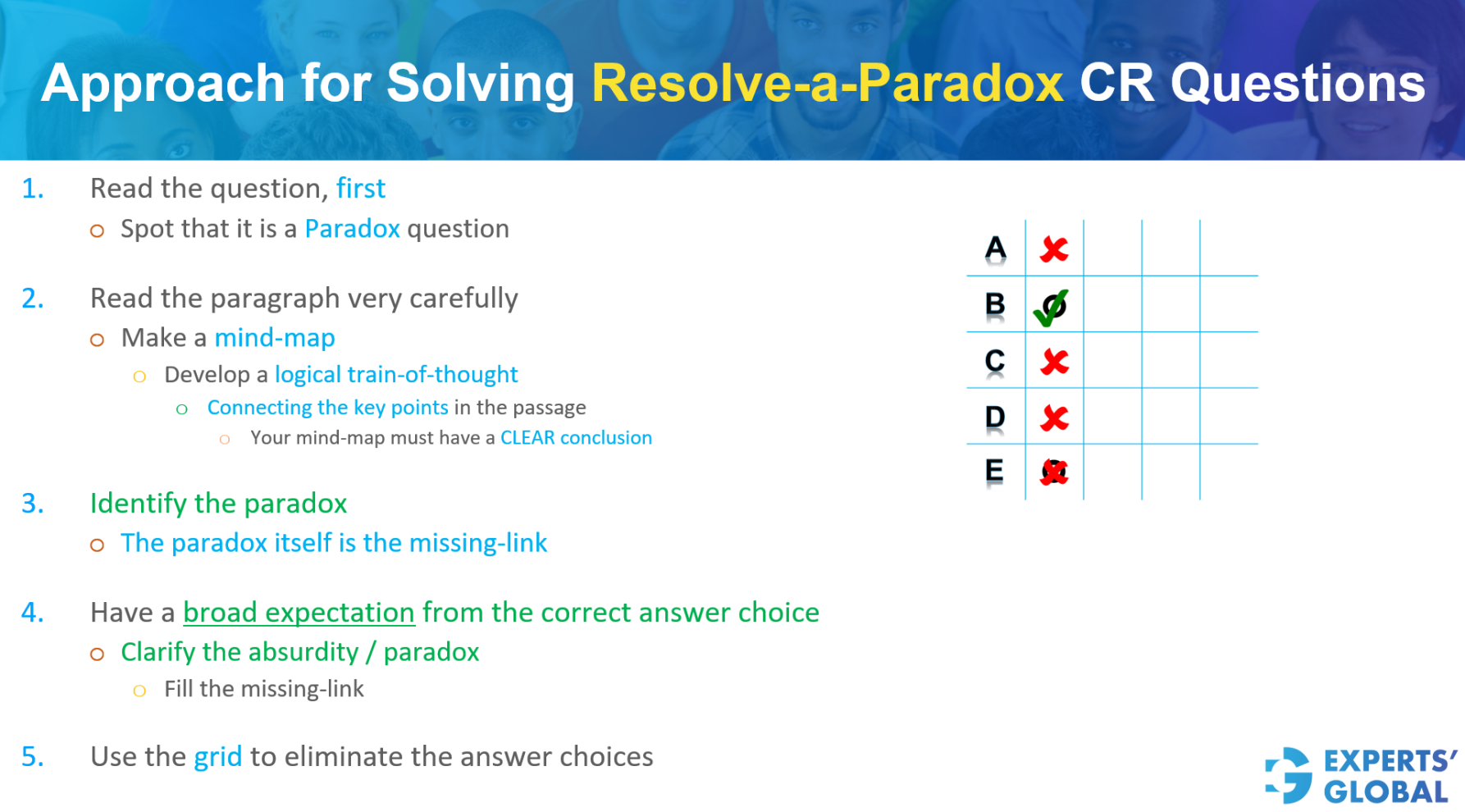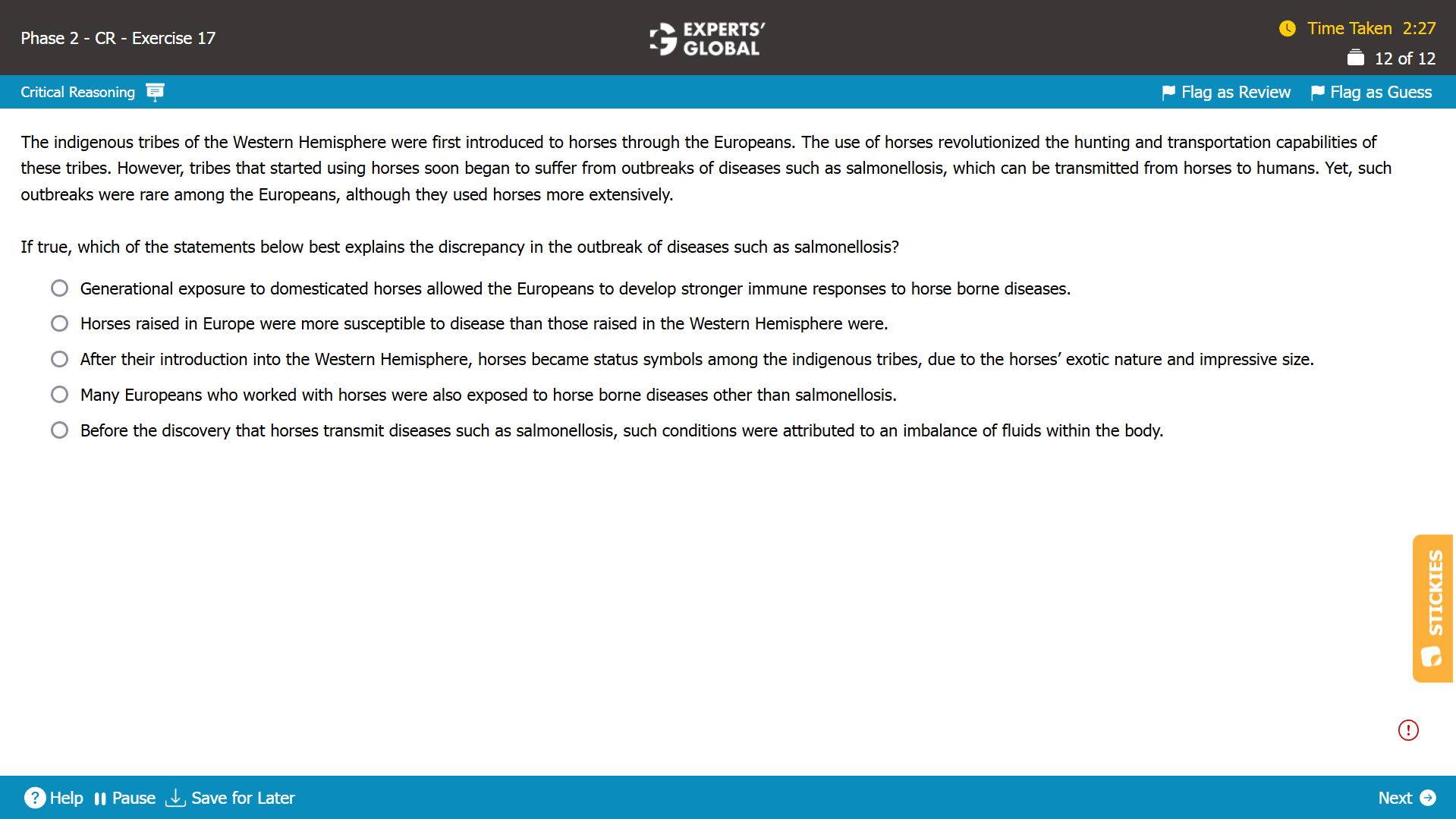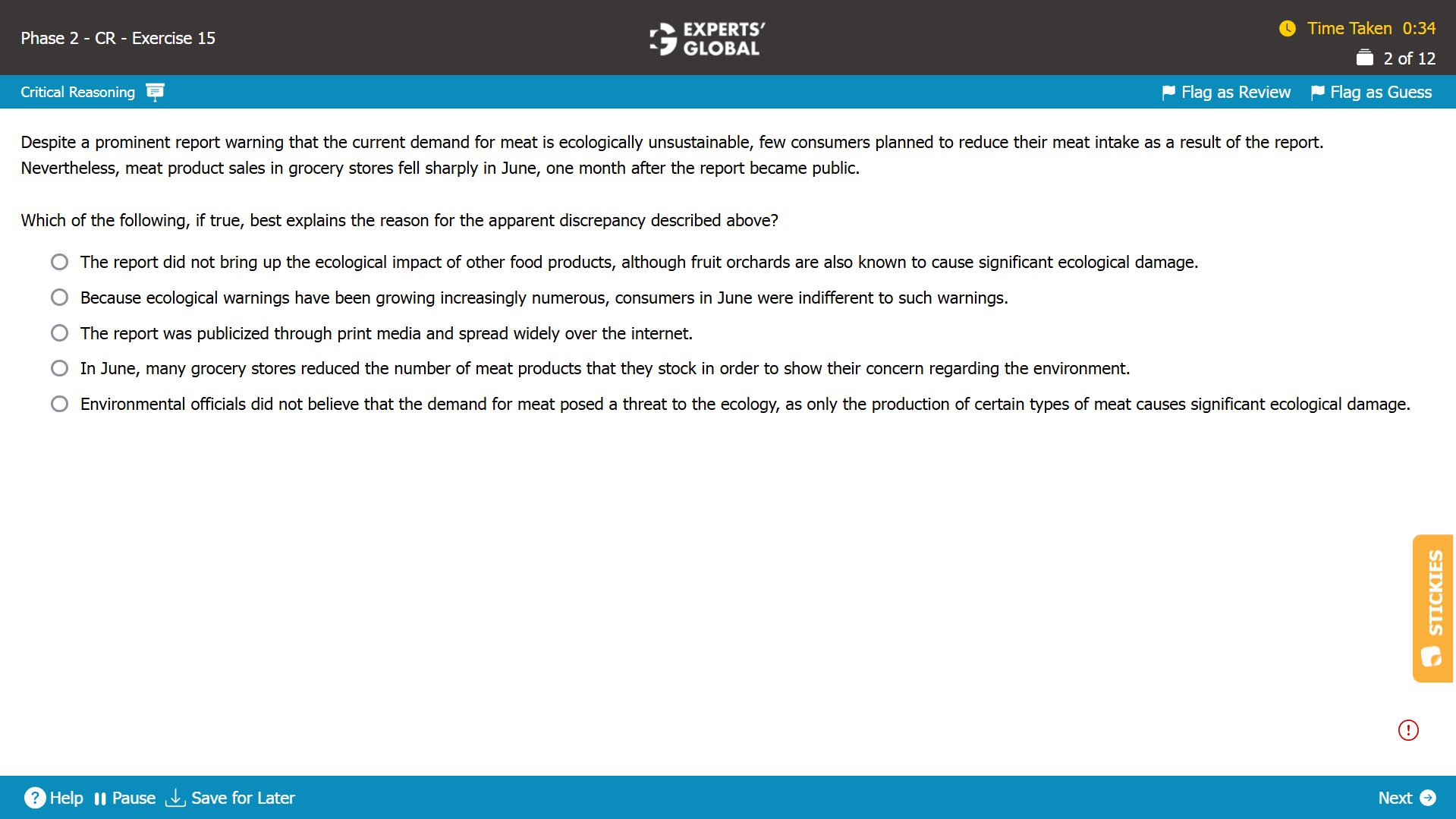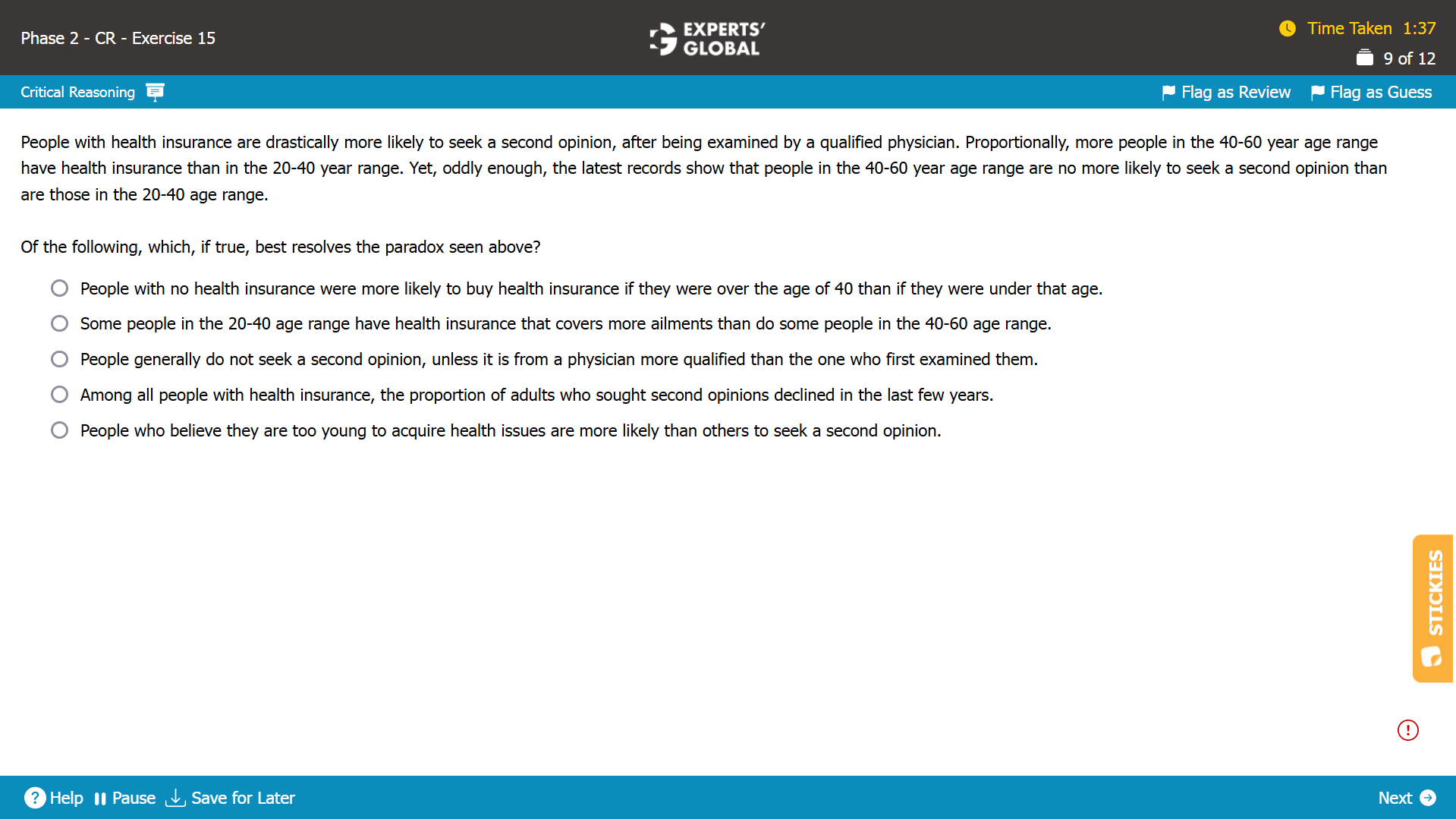Invest 30 seconds...
...for what may lead to a life altering association!
Help Line
- +91.8800.2828.00 (IND)
- 1030-1830 Hrs IST, Mon-Sat
- support@expertsglobal.com
...for what may lead to a life altering association!


Critical Reasoning Resolve the Paradox questions ask you to find the statement that explains why two facts that seem to conflict can actually be true at the same time. They help you learn how to reconcile surprising patterns by identifying the missing idea that brings the situation into balance. Regular practice with this question type is an essential part of any complete GMAT preparation course. This page offers you an organized subtopic wise playlist, along with a few worked examples, for efficient preparation of this concept.
Resolve a paradox or explanation questions in GMAT Critical Reasoning present an apparent conflict: the premise seems to suggest one outcome, while the observed result points in another direction. This overview explains how such questions are addressed by finding a bridging reason that harmonizes the two sides. The video and article describe common reconciliation patterns and demonstrate how to read the question stems with speed and precision. This short video describes the approach, illustrates its application, and helps you deploy it in GMAT drills, sectional tests, and full-length GMAT mock tests.


Numbers in Critical Reasoning may sound convincing, but their real force depends on context, comparison, and how they connect to the conclusion. This overview explains how to read data with discipline: ask “compared to what,” check whether the figures match the scope of the claim, and see how each metric relates to the main point. Pay close attention to benchmarks and possible alternative causes that might explain the same result. The video and article show how carefully used numbers can strengthen, weaken, explain, or evaluate an argument. The following short video takes this concept from theory to practice and shows how it can appear on the GMAT.

In this section, you will practise a series of GMAT-style Critical Reasoning Resolve-the-Paradox questions, each followed by a careful, line by line explanation. Work through every stimulus at a measured pace and consciously use the reasoning tools and patterns you have just studied on this page for resolving apparent contradictions on the GMAT. At this stage, give greater priority to applying the structured approach accurately than to simply picking the option that seems right. After you finish a question, use the explanation toggle to reveal the credited answer and review the full explanatory reasoning.

Show Explanation

Written Explanation
Mind-map: Europeans introduced horses to indigenous tribes → horses revolutionized tribal life → tribes acquired diseases transmitted from horses → Europeans used horses more extensively → diseases were rare among Europeans
Missing-link: Between the Europeans using horses as extensively as the indigenous tribes doing and diseases being rare among the Europeans but common among the indigenous tribes
Expectation from the correct answer choice: To explain why the diseases were rare among the Europeans but common among the indigenous tribes despite the Europeans using horses as extensively as the indigenous tribes doing
A. Correct. This answer choice, suggesting that the Europeans had stronger immunity to horse borne diseases because of generational exposure to the diseases, indicates that the indigenous tribes, lacking generational exposure to horses, were more susceptible to horse borne diseases, thus explaining why the tribes acquired the disease but the Europeans didn’t even if the Europeans used horses more extensively. Because this answer choice clarifies the exact discrepancy, this answer choice is correct.
B. This answer choice, suggesting that the horses with the Europeans were more susceptible to disease than the horses with the indigenous tribes, indicates that the Europeans likely had greater exposure to the disease and that the diseases were likely more common among Europeans; so, this answer choice, if anything, raises further concern over, rather than explains, why the diseases were rare among Europeans. Because this answer choice does not explain the discrepancy in the argument, this answer choice is incorrect.
C. This answer choice, suggesting that the horses were a status symbol in the tribes, simply indicates the horse’s popularity among the tribals and makes no suggestion regarding why diseases transmitted from horses were rare among the Europeans but common among the indigenous tribes, thus failing to clarify the discrepancy in the argument. Besides, the argument mentions that the Europeans used horses more extensively than the indigenous tribes did, thus accounting for all the usage regardless of this reason for the usage; so, this answer choice, suggesting popularity as a reason among the indigenous tribes, provides no information useful to clarify the discrepancy in the argument. Because this answer choice does not explain the discrepancy in the argument, this answer choice is incorrect.
D. If many Europeans were exposed to several horse borne diseases, the Europeans are likely at risk of acquiring diseases transmitted from horses; so, this answer choice, if anything, raises further concern over, rather than explains, why the diseases were rare among Europeans. Further, “many” refers to only a part of all the Europeans with horses and is thus, limited in scope. Because this answer choice does not explain the discrepancy in the argument, this answer choice is incorrect.
E. This answer choice, suggesting the lack of understanding of how the diseases transmitted from horses were acquired, provides no information about any difference between the indigenous tribes and the Europeans; so, this answer choice is just additional detail and fails to explain why the diseases were rare among Europeans. Because this answer choice does not explain the discrepancy in the argument, this answer choice is incorrect.
A is the best choice.

Show Explanation

Written Explanation
Mind-map: Report warns that demand for meat is ecologically unsustainable → only few consumers reduced meat intake → sales of meat fell after a month
Missing-link: Between only few consumers reducing meat intake and the sales of meat falling sharply after a month
Expectation from the correct answer choice: To explain why the sales of meat fell sharply after a month despite only few consumers reducing meat intake
A. The argument is concerned with the report’s findings about “meat” and the warning’s effect on meat consumption; so, the findings related to “other food products” are out of scope. Because this answer choice does not explain the discrepancy in the argument, this answer choice is incorrect.
B. This answer choice, suggesting indifference of consumers to warnings, supports the fact that only few consumers reduced meat intake after the report’s warning but does not explain why the sales of meat fell after a month despite only few consumers reducing meat intake. Because this answer choice does not explain the discrepancy in the argument, this answer choice is incorrect.
C. The argument is concerned with why the sales of meat fell after a month; so, information about how the report was publicized or whether the report was widespread is just additional information and does not explain why the sales of meat fell after a month despite only few consumers reducing meat intake. Because this answer choice does not explain the discrepancy in the argument, this answer choice is incorrect.
D. Correct. This answer choice, suggesting a reduction in the number of meat products in grocery stores, indicates that the sales of meat fell in June because of the unavailability of meat in stores, thus explaining why the sales of meat fell in June despite only few consumers reducing meat intake. Because this answer choice clarifies the exact discrepancy, this answer choice is correct.
E. If environmental officials’ opinion differed from the report, it supports the fact that only few consumers, if aware of the officials’ opinion, reduced meat intake but does not explain why the sales of meat fell after a month despite only few consumers reducing meat intake. Because this answer choice does not explain the discrepancy in the argument, this answer choice is incorrect.
D is the best choice.

Show Explanation

Written Explanation
Mind-map: People with health insurance more likely to seek second opinion → higher proportion of people in 40-60 age range have health insurance than in 20-40 age range → people in 40-60 age range were not more likely to seek second opinion than people in 20-40 age range
Missing-link: Between a higher proportion of people in 40-60 age range having health insurance than in 20-40 age range and people in 40-60 age range not being more likely to seek a second opinion than people in 20-40 age range
Expectation from the correct answer choice: To explain why people in 40-60 age range were not more likely to seek a second opinion than people in 20-40 age range despite a higher proportion of people in 40-60 age range having health insurance than in 20-40 age range
Note: This question represents a common GMAT dilemma of choosing the “best answer choice” among all “unconvincing answer choices”; in such a scenario, it becomes all the more important to “go-by-elimination”; an answer choice that you find “least unconvincing” is likely the correct answer choice.
A. This answer choice, suggesting that people above 40 were more likely to buy health insurance for the first time than younger people, is consistent with the fact in the argument that a higher proportion of people in the 40-60 age range have health insurance than in the 20-40 age range and makes no suggestion regarding the likelihood of seeking a second opinion in the two age groups; so, this answer choice is just additional information and fails to explain why people in 40-60 age range were not more likely to seek a second opinion than people in the 20-40 age range. Because this answer choice does not explain the discrepancy in the argument, this answer choice is incorrect.
B. This answer choice, comparing the coverage of health insurance between some people in the two age groups, makes no suggestion regarding the likelihood of seeking a second opinion in the two age groups; so, this answer choice is just additional information and fails to explain why people in the 40-60 age range were not more likely to seek a second opinion than people in the 20-40 age range. Further, “some” refers to only a part of all the people and is thus limited in scope. Because this answer choice does not explain the discrepancy in the argument, this answer choice is incorrect.
C. This answer choice, suggesting that second opinions are generally sought from physicians that are more qualified than the earlier physicians, simply indicates a condition while seeking a second opinion; such a condition would be applicable to people in both the age groups and thus fails to explain any difference between the two groups. Additionally, this answer choice makes no suggestion regarding the likelihood of seeking a second opinion in the two age groups. Overall, this answer choice is just additional detail and fails to explain why people in the 40-60 age range were not more likely to seek a second opinion than people in the 20-40 age range. Because this answer choice does not explain the discrepancy in the argument, this answer choice is incorrect.
D. Trap. This answer choice, suggesting a trend among people with health insurance, would be applicable to people in both the age groups and thus fails to explain any difference between the two groups. Additionally, this answer choice makes no suggestion regarding the likelihood of seeking a second opinion in the two age groups. Overall, this answer choice is just additional detail and fails to explain why people in the 40-60 age range were not more likely to seek a second opinion than people in the 20-40 age range. Because this answer choice does not explain the discrepancy in the argument, this answer choice is incorrect.
E. Correct. This answer choice, suggesting that younger people are more likely to seek a second opinion than older people, indicates that people in the 20-40 age range, owing to their belief that they are too young to acquire health issues, are more health conscious and thus more likely to seek a second opinion than people in the 40-60 age range; in other words, this answer choice introduces an additional factor that affects the likelihood of seeking a second opinion and may explain why people in the 40-60 age range were not more likely to seek a second opinion than people in the 20-40 age range. Among all the answer choices deemed unconvincing, this choice is the least prone to elimination and can be considered the “best” answer option.
E is the best choice.
High quality CR Resolve-the-Paradox questions are not available in large numbers. Among the limited, genuinely strong sources are the official practice materials released by GMAC and the Experts’ Global GMAT course. Within the Experts’ Global GMAT online preparation course, every CR Resolve-the-Paradox question appears on an exact GMAT like user interface that includes all the real exam tools and features. You work through more than 40 CR Resolve-the-Paradox questions in quizzes and also take 15 full length GMAT mock tests that include several CR Resolve-the-Paradox questions in roughly the same spread and proportion in which they appear on the actual GMAT.
All the best!